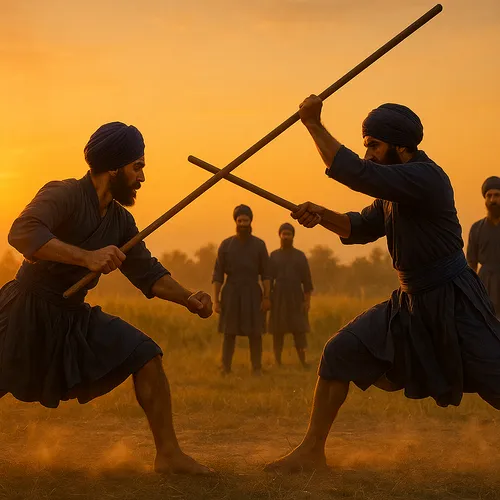Traditional Gatka

Traditional Gatka is the classical martial art of the Sikh Khalsa, practiced as both a combat discipline and spiritual path. Unlike its sport counterpart, Traditional Gatka focuses on battlefield techniques, fluid circular movements, and the integration of martial ethics with devotion. Rooted in the teachings of the Sikh Gurus and warrior saints, it emphasizes real blade work, control of timing and distance, and the preservation of ancient shastar vidiya knowledge. Training is often conducted in akharas under the guidance of ustads, with deep respect for lineage and sacred tradition. It remains a living embodiment of Sikh martial heritage passed through generations.
Traditional Gatka Essentials
About Traditional Gatka
Discover the foundations of Traditional Gatka—a martial art born on historical battlefields, practiced today to preserve the spiritual and warrior code of the Khalsa. This section introduces its depth, purpose, and transmission through akharas.
Traditional Gatka History
Explore the evolution of Gatka from the time of Guru Hargobind and Guru Gobind Singh to the resistance against the Mughals and British. Learn how Traditional Gatka survived suppression and continues as a lineage-based warrior art.
Philosophy & Approach
Traditional Gatka trains the practitioner as a saint-soldier, where martial discipline is aligned with divine will (hukam). Learn how spiritual grounding, humility, and devotion guide every movement and mindset.
Techniques & Style
Delve into the flowing, circular strikes and redirection techniques of Traditional Gatka. This section includes methods such as pharla, chakkar, and advanced blade concepts used in live and ceremonial training.
Traditions & Etiquette
Training begins and ends with ardaas (prayer), and students maintain respect for the Guru, shastar, and teacher. Learn how protocols, greetings, and rituals uphold the spiritual integrity of the art.
Uniform & Symbols
Practitioners wear traditional Sikh warrior attire: blue or saffron baana, dumalla turbans, and symbolic weapons. This section explores the meaning behind every garment and spiritual accessory.
Weapons
Traditional Gatka includes real shastar such as khanda, kirpan, barcha, chakkar, dhal, and more. Learn how these weapons are used with reverence and technical mastery in training and performance.
Ranking System
There are no colored belts—rank is earned through years of discipline, knowledge of shastar, and mastery of technique. Discover how respect, not certification, defines progression in this lineage-based art.
Traditional Gatka Glossary
A comprehensive glossary of Gurmukhi and martial terminology used in Traditional Gatka. Includes names of weapons, strike patterns, spiritual concepts, and training roles.
Notable Figures
Meet legendary figures such as Guru Gobind Singh, Baba Deep Singh, and renowned ustads who have kept Traditional Gatka alive through centuries of struggle and devotion.
Branches & Organizations
Learn about respected akharas and teacher lineages in India and abroad that carry the traditional form of Gatka. This section highlights non-sport institutions rooted in shastar vidya and Khalsa principles.
Competitive Format
Traditional Gatka is not sport-oriented, but martial demonstrations and performance duels are used to showcase skill. Learn how public displays honor warrior tradition without point scoring.

